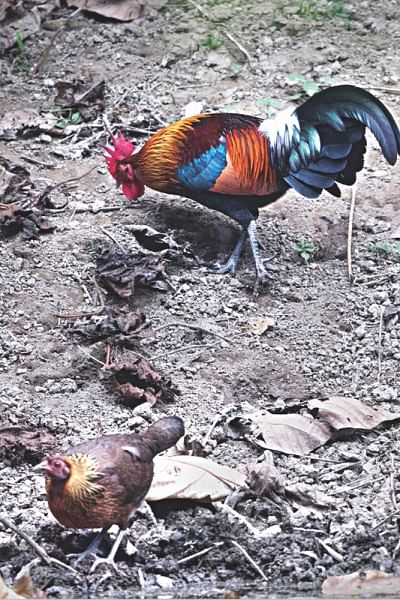Tangents: Red Junglefowl

The chicken is the most ubiquitous bird in the world. There are over 23 billion chickens in the world, providing nutrition to humanity. How did it come to be? It was domesticated from a wild bird, the Red Junglefowl, over five thousand years ago.
The Red Junglefowl, known in Bangla as Bon Morog, was a part of my childhood. It was found in rural areas all over Bangladesh. For example, it was common in a bamboo grove and adjoining jungles behind our house in Sylhet. It was often hunted or caught in nets and, on occasion, graced our dinner table as an exotic addition.
The bird belongs to a family of birds that also includes pheasants, peacocks, grouses, partridges, quails, francolins. This family, Phasianidae, is spread all over the globe and comprises of 187 species. Many of these varieties once roamed the forests and fields of Bangladesh. Today we can still see some pheasants, quails and francolins. These include the Kalij Pheasant (Mothura), and Black Francolins (Kalo Titir). But they are rare and extremely wary of people.
The Red Junglefowl is relatively easier to find. I have encountered it many times, usually spotting it in border areas of the forest. For example, it can be reliably seen at the edges of rice paddies abutting the jungles of Rema Kalenga forest. Our tea gardens also host this bird. If you go to Sundarban, you are virtually guaranteed to see it when it comes out of the forest to the edge of water, picking for food on the grass.
Called Gallus gallus in Latin, the Red Junglefowl is divided into five subspecies (that is, races.) The one found in our subcontinent is called Gallus gallus murghi.
Foraging for food on the ground, the bird eats mainly grains, seeds, fruits, shoots of grass as well as insects. Like the domestic chicken, it rakes fallen leaves and grass looking for morsels of food. It builds its nest on the ground, covered by dense undergrowth. It likes bathing in the sand and will fly short distances to climb a tree, display for mating, or escape danger. The male's crowing is loud and distinct. It is heard early morning or late afternoon and resembles the call of a domestic rooster.
The male Red Junglefowl is longer than our domestic chicken. It is colourful, sporting orange-red and golden yellow feathers on its back. The long black tail is curled like a sickle. There is a red comb above its bill. The female is brown and yellow, with a stockier body than the male. It lacks the tail feathers of the male and more closely resembles the domestic chicken.
Photographing the Red Junglefowl in a good pose is difficult because it constantly moves around on the ground. The best moment to catch it is when it spreads its wings. It reveals some fantastic colourful patterns then. Since it flies slowly, you can also try to photograph it in flight.
facebook.com/ikabirphotographs or follow ihtishamkabir on Instagram.

 For all latest news, follow The Daily Star's Google News channel.
For all latest news, follow The Daily Star's Google News channel. 



Comments